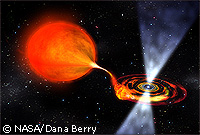ESA astronomers spot cannibal pulsar eating companion star
ESA's Integral space observatory, together with NASA's Rossi X-ray Timing Explorer spacecraft, has found a fast-spinning pulsar in the process of devouring its companion. This finding, reported in the latest issue of Astronomy and Astrophysics Journal, supports the hypothesis that binary pulsars evolve into fast-spinning isolated pulsars by cannibalising a nearby star. Gas ripped from the companion fuels the pulsar's acceleration. The researchers describe it as 'an evolutionary step' between a stately life as a binary pulsar, spinning around once or twice a second and the fast lane of being an X-ray millisecond pulsar. This is the first system in which the pulsar has been caught in the act of speeding itself up. 'We're getting to the point where we can look at any fast-spinning, isolated pulsar and say, 'That guy used to have a companion',' said Dr Maurizio Falanga, who led the Integral observations at the Commissariat à l'Energie Atomique (CEA) in Saclay, France. Pulsars are rotating neutron stars - one of the possible final destinies for a star. They evolve from massive stars that were once at least eight times more massive than the Sun. After these stars have finished burning their nuclear fuel, they undergo a supernova explosion. This explosion blows off the outer layers of a star into a supernova remnant. The central region of the star collapses under its own gravity with so much force that protons and electrons combine to form neutrons. While neutron stars have roughly the same mass as our own Sun does now, they are compacted into a sphere of only about 20 kilometres across. Neutron stars may appear in supernova remnants, as isolated objects, or in binary systems containing two stars that orbit around their common centre of mass. Neutron stars are born rapidly spinning but they gradually slow down after a few hundred thousand years. Neutron stars in binary star systems, however, can reverse this trend and speed up with help from their companion star. A neutron star can remove gas from its companion star in a process called 'accretion'. The flow of gas onto the neutron star makes the star spin faster and faster. For the first time ever, this speeding-up has been observed as it happens. 'We now have direct evidence for the star spinning faster whilst cannibalising its companion, something which no one had ever seen before for such a system,' said co-author Dr Lucien Kuiper from the Netherlands Institute for Space Research (SRON), in Utrecht. This pulsar, called IGR J00291+5934, was identified by the European Space Agency's (ESA) Integral space observatory, during a routine scan of the outer edges of the Milky Way in December 2004. The following day, NASA observers used Rossi's X-ray Timing Explorer spacecraft to work out just how fast the object was spinning. Rossi observations revealed that the companion is already a fraction the size of our Sun, perhaps as small as 40 Jupiter masses. The binary orbit is 2.5 hours long, with the full system being so tight that both stars would fit into the radius of the Sun. These details support the theory that the two stars are close enough for accretion to take place and that the companion star is being cannibalised.
Countries
Finland, France, Netherlands, United States



